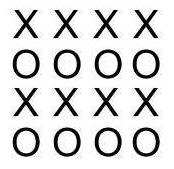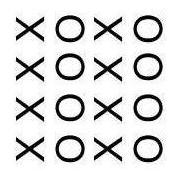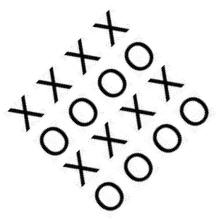Dyslexia
Short Description
Many dyslexics can substantially reduce their reading difficulties by turning the book at a 45 degree angle, as in the figure on the right.

Many dyslexics already turn their book; they just need to turn it more (and learn to read at this angle, which is not difficult).
Underlying Deficit
Imagine that in the figure below, the letters are evenly spaced. Most people will see rows. Their perceptual system automatically and unconsciously does this grouping, based on what is called the "Gestalt principle of similarity" – similar things are grouped together.

In the next figure, most people see columns.

Jim Lewis and I found that about 50% of college dyslexics had a deficit seeing rows in the first figure. We called this "row blindness." Some of these dyslexics also had difficulties seeing the columns in the second figure. But most could see columns, and we found that normal grouping usually occurs at around a 45 degree angle.

Informally, this deficit has a strong genetic component.
Avoiding This Problem
Reading English requires grouping in rows: Letters have to be grouped into words, and words have to be grouped into lines. Row blindess then leads to problems reading letters in rows.
The solution is simple. If a person has row-blindness but normal perceptual grouping at a 45 degree angle, then turn the page to the diagonal, as in the figure above. It would be equally effective to simply cock the head at a 45 degree angle, though presumably this would become uncomfortable.
Of course, if someone is accustomed to reading when the text is horizontal, then it is difficult at first to read at an angle. However, this is just a matter of practice. The dyslexic can slowly increment the angle of the text or abruptly change to the optimal angle.
Will This Work?
If a dyslexic does not have row-blindness, there is no reason to expect that this will work. And if a dyslexic cannot group normally when things are diagonal or a column, there is no reason to expect it to work.
Otherwise, it will probably help reading to hold the page so the rows run diagonally. One dyslexic reported successfully using this method. He also reported seeing it published in a newspaper. In our research, we found that most row-blind dyslexics held the page at an angle, whereas people without this decifit did not. Therefore, most row-blind dyslexics are already using this method. However, no dyslexic was holding the book at a 45 degree angle, which is what we believe to be optimal.
From our sample, a very rough guess is that this solution will work on about 50% of dyslexics. One dyslexic who uses this method reported reading about it in a newspaper, so apparently we are not the first to suggest this.
What to Do
If you know someone with reading difficulties, draw a figure like the one above with X's and O's. Try to space the letters evenly. Based on our experience, you do not need great accuracy to do this test.
Have them first view it so the grouping produces rows and ask if they see rows. Next, have them view it so the grouping produces columns and ask if they see columns.
If they do not see rows, but they do see columns, then they are row-blind but have normal perceptual grouping for columns. If they say they see both, then they are probably not row-blind, though it is possible they are not answering correctly. If they see neither, either they do not understand the instructions or they are both row-blind and column-blind. You should test what they see when the grouping is diagonal.
The person you are testing should not tilt their head. If they do, you can probably assume they are row-blind; people without row-blindness have no reason to tilt their head.
If you find someone who is row-blind, rotate the card until you find the minimal angle needed to produce the strongest grouping. This is the angle that the person should be reading at.
(Another strategy might be moving the head or text, though we have not investigated this and it would seem to otherwise make reading difficult.)
Our Research Article
A dyslexic fast reader who writes at a 90 degree angle
